Planarians - Study guides, Revision notes & Summaries
Looking for the best study guides, study notes and summaries about Planarians? On this page you'll find 20 study documents about Planarians.
Page 2 out of 20 results
Sort by
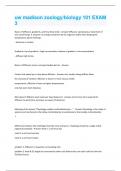
-
uw madison zoology/biology 101 EXAM 3 Questions With 100% Correct Answers.
- Exam (elaborations) • 44 pages • 2024
-
- £6.86
- + learn more
Basics of diffusion, gradients, and how they relate - Answer-Diffusion: spontaneous movement of very small things. It requires no energy investment by the organism (other than keeping the temperature above freezing) --direction is random Gradients: top of gradient = high concentration, bottom of gradient = low concentration --diffuses high to low Basics of diffusion across a semipermeable barrier - AnswerFactors that speed up or slow down diffusion - Answer-size: smaller things diffuse fas...
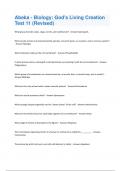
-
Abeka - Biology: God's Living Creation Test 11 (Revised) Questions and Answers 2024 Complete;100%
- Exam (elaborations) • 5 pages • 2024
- Available in package deal
-
- £6.54
- + learn more
What group includes snails, slugs, conchs, and nudibrancks? - Answer-Gastropods What sessile animals are characterized by spicules, incurrent pores, an osculum, and no nervous system? - Answer-Sponges What molecules make up the cell membrane? - Answer-Phospholipids In what process does a cell engulf a solid particle by surrounding it with the cell membrane? - AnswerPhagocytosis Which group of invertebrates are characterized by a muscular foot, a visceral hump, and a mantle? - Answer-Mollus...
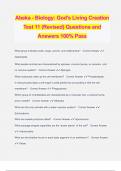
-
Abeka - Biology: God's Living Creation Test 11 (Revised) Questions and Answers 100% Pass
- Exam (elaborations) • 6 pages • 2024
-
- £9.40
- + learn more
Abeka - Biology: God's Living Creation Test 11 (Revised) Questions and Answers 100% Pass What group includes snails, slugs, conchs, and nudibrancks? - Correct Answer ️️ - Gastropods What sessile animals are characterized by spicules, incurrent pores, an osculum, and no nervous system? - Correct Answer ️️ -Sponges What molecules make up the cell membrane? - Correct Answer ️️ -Phospholipids In what process does a cell engulf a solid particle by surrounding it with the cell me...
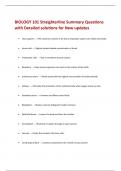
-
BIOLOGY 101 Straighterline Summary Questions with Detailed solutions for New updates
- Exam (elaborations) • 5 pages • 2024
- Available in package deal
-
- £6.54
- + learn more
• vital capacity - -The maximum volume of air that a respiratory system can inhale and exhale. • tissue cells - -highest carbon dioxide concentration is found • Prokaryotic Cells - -lack a membrane bound nucleus • Biosphere - -layer where organisms can exist on the surface of the Earth. • pulmonary artery - -blood vessel with the highest concentration of carbon dioxide. • Kidneys - -stimulate the production of the red blood cells when oxygen levels are low. • lymphatic ...
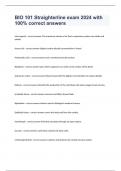
-
BIO 101 Straighterline exam 2024 with 100% correct answers
- Exam (elaborations) • 5 pages • 2024
-
- £12.67
- + learn more
vital capacity - correct answer The maximum volume of air that a respiratory system can inhale and exhale. tissue cells - correct answer highest carbon dioxide concentration is found Prokaryotic Cells - correct answer lack a membrane bound nucleus Biosphere - correct answer layer where organisms can exist on the surface of the Earth. pulmonary artery - correct answer blood vessel with the highest concentration of carbon dioxide. Kidneys - correct answer stimulate the production of...
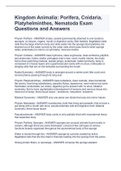
-
Kingdom Animalia: Porifera, Cnidaria, Platyhelminthes, Nematoda Exam Questions and Answers
- Exam (elaborations) • 3 pages • 2022
-
- £8.17
- + learn more
Phylum Porifera - ANSWER simple, sessile (permanently attached to one location) sponges; no tissues, organs, mouth or digestive cavity; filter feeders: flagellated collar cells line the large internal cavity and draw water into the sponge (food particles are strained out of the water current by the collar cells which pass food to other sponge cells); acolemate (no colon); no symmetry; most are marine Phylum Cnidaria - ANSWER class hydrozoa, class scyphozoa, class anthozoa; jellyfish, sea anem...
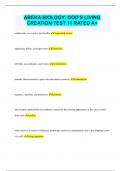
-
ABEKA BIOLOGY: GOD'S LIVING CREATION TEST 11 RATED A+
- Exam (elaborations) • 8 pages • 2024
-
- £6.54
- + learn more
earthworms, sea worms, and leeches segmented worms planarians, flukes, and tapeworms flatworms jellyfish, sea anemones, and hydras coelenterates animals characterized by spiny skin and radial symmetry echinoderms euglenas, amoebas, and paramecia protozoa microscopic multicellular invertebrates named for the rotating appearance of the cilia on their front ends rotifers what consists of stacks of flattened, membrane-enclosed compartments and is the shipping center of a cell? Golgi apparatu...
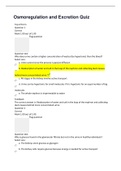
-
BIO 123-20103 Osmoregulation and Excretion Quiz (100% CORRECT Solutions)
- Exam (elaborations) • 10 pages • 2022
- Available in package deal
-
- £8.99
- + learn more
Osmoregulation and Excretion Quiz Top of Form Question 1 Correct Mark 1.00 out of 1.00 Flag question Question text Why does urine contain a higher concentration of wastes (be hypertonic ) than the blood? Select one: a. Urine cannot since the process is passive diffusion b. Reabsorption of water and salt in the loop of the nephron and collecting ducts leaves behind more concentrated urine c. All stages in the kidney involve active transport d. Urine can be hypertonic for small molecules if it is ...
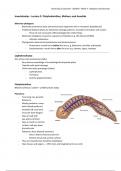
-
Invertebrates Lecture 2 Notes - Platyhelminthes, molluscs and annelids
- Lecture notes • 6 pages • 2024
- Available in package deal
-
- £5.36
- + learn more
Detailed and concise FIRST CLASS notes which are easy to understand and learn from, covering the second lecture of Invertebrate Zoology in the BS1070 module.
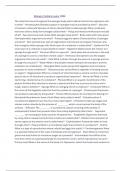
-
Biology midterm 2 exam 2024
- Exam (elaborations) • 2 pages • 2024
-
- £12.67
- + learn more
The cells that move throughout the sponges body wall to deliver food to the organisms cell is what? - Amoebocytes Skeletal support in sponges may be provided by what? - Spicules of calcium carbonate Spicules of silicon dioxide Fibers called spongin Many cnidarians have two distinct body forms/stages called what? - Polyp and medusa Anthozoans include what? - Sea anemones and corals Adult sponges have what? - Body walls with many pores Hermaphroditic organisms do what? - Produce egg and ...

Study stress? For sellers on Stuvia, these are actually golden times. KA-CHING! Earn from your revision notes too and start uploading now. Discover all about earning on Stuvia


